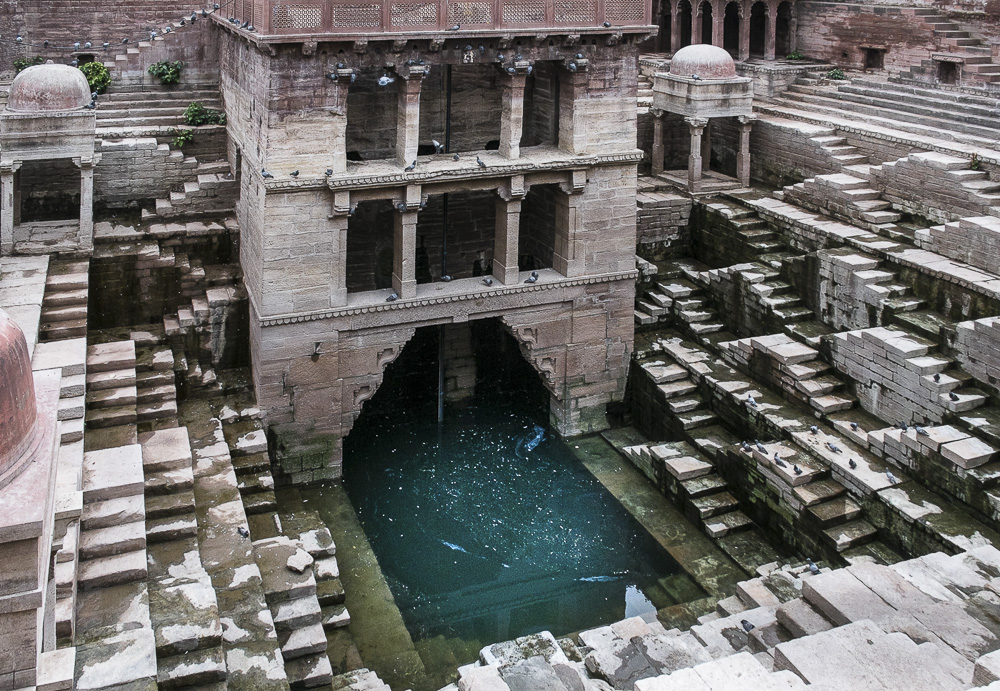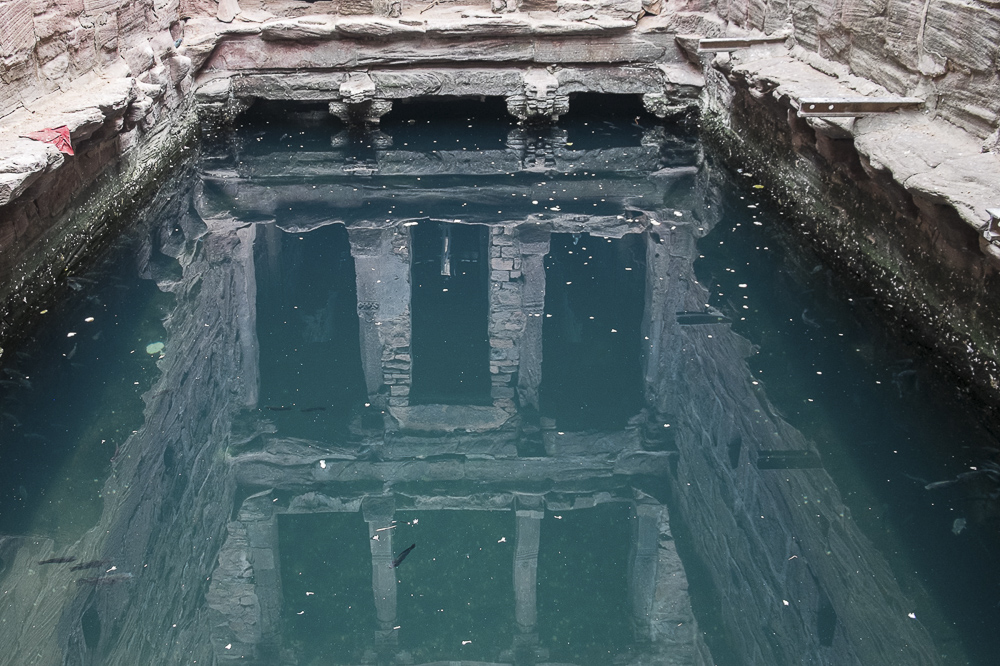A captivating slideshow about India’s stepwells landed on my computer screen some time ago – architectural masterpieces, with flights of stairs going down to a pool of water deep below the ground, and then up again, in Escher-like - configurations. Built hundreds of years ago, mostly in the arid Western regions of India in the loose, sandy soil, they enabled the local population to reach the water table that is very low in severe drought, but also fluctuates heavily with the summer monsoons.
I was hooked. These images struck my imagination, though I did not yet understand why. Beyond my recognition of the stepwells as visually stunning in terms of their architecture, I sensed that these stairways down into the earth evoke something much, much deeper.
Joining my friend Doreen Bahiri on a trip to Gujarat and Rajasthan in her search for traditional textile arts, I realized that stepwells abound in these desert regions. Finding and photographing stepwells became a second, most compelling mission of our trip. In the end, we managed to find nine stepwells, plus several more reservoirs and tanks that technically are not stepwells, even if they might have steps, since they are not fed by groundwater wells. It turned out most of the stepwells required quite a lot of detective work to locate. Unlike many of India’s architectural treasures, they are not on the tourist map. They are indeed, forgotten.
Two and a half years later, in the fall of 2018, when Doreen and I went trekking in Nepal, we decided to add one more week in Rajasthan and Delhi – she, to find more ethnic arts, and I, to continue my quest for stepwells. This time we are able to find twelve more wells – five in and around Jaipur, one in Abheneri, two in the Shekhawati region of Rajasthan and four more in Delhi. Other than the better-known Chand Baori in Abheneri, and the Panna Meena Ka Kund in Jaipur, these stepwells again required a lot of persistence to find, with only rudimentary data about their location on the web. We succeeded due to the resourcefulness of our trusted rickshaw drivers whom Doreen has known for years, and who asked around for further clues and directions. (*)
stepwell at the foot of Fort Nassau, Curaçao
The image of steps going down to reach the water in a well strikes a familiar chord in me. On the arid Caribbean island where I grew up, the groundwater level was always low. Wind-driven pumps on wells were common, and every drop of rain had to be preserved by dams, tanks and cisterns. There were also pos di pia – “foot wells” - sometimes just a slanted surface to walk down to the water, but at times also built with steps. Except that the elaborate Indian constructions far surpass these humble, utilitarian walk-down wells of Curaçao.
I have a strange fascination with enclosed spaces that hold water. The cistern of my childhood memories in Curaçao, the “house of water”, plays a central role in my book, House without Doors (1), whose title alludes to it. Following her urge to explore her old house’s dark, mysterious places, the book’s young protagonist comes upon a cave in the cellar that takes her to a vast under-earth sea, deep into the ground – leading the reader to wonder whether it is a fantasy or not.
In December 2019, my son, the artist Itamar Mendes-Flohr, created an experiential, water-rich exhibit - “That we’ve Forgotten the Rain” - in the cellars of the Mamuta Art Center at the Hansen House, inspired by the rain-cisterns of that former Leper hospital compound where Itamar wandered as a child when the structures were abandoned - long before it was turned into a vibrant art center where he has been active for several years. (2) As we lived nearby, he would often sneak into the buildings and explore their dark, mysterious spaces and rain cisterns, something I did not know until he spoke about it in the context of this exhibit. It is amazing that his strong attraction to subterranean waters was born independently of my own, or could it have been inherited?
photograph by Itamar Mendes-Flohr
As an erstwhile student of architecture, I have always been less interested in the visual qualities of a building, than in its visceral and kinesthetic dimensions – how you experience it with all your senses, not only your eyes. I ask how a built environment invites you to move; what subtle sensations it arouses as you walk through it; the archetypal images it awakens; how it transforms you, like an initiation rite or a pilgrimage would.
And so, it was important to me to physically go down into the stepwells, to experience the architectural space from within, as it was meant to be experienced. This proved not always possible, sometimes because of my own fears - of slipping down from the narrow steps into the depths, in in an attack of vertigo. Or because the wells were so neglected that the amount of refuse lying on the steps and at its bottom in the fetid water, was so unappealing that I only ventured down a few steps. Or they were in such deserted areas, that I feared being accosted by men who might be hiding out in their underground chambers.
But most of the time the obstacle was that the wells were locked up, fenced in. The reasons – or rationalizations – for their being off limits to visitors played on the primal fears of these holes into the earth: two illicit couples committed suicide by jumping to their deaths in one; children were said to have drowned in others; or the place was “infested with snakes and scorpions”. The British, in their long rule of India, sealed many of the stepwells for supposed hygienic reasons, allowing these magnificent structures to fall into disuse and disrepair – and be mostly forgotten.
The archetypal images aroused by the stepwells - whether I actually went down or contemplated the well from above – speak of the journey deep into the subconscious, images studied by Jung and that the philosopher Gaston Bachelard takes to architectural settings in The Poetics of Space, a book that inspired me to write House without Doors.
The Indian stepwells, with their long flights of stairs, evoke a descent into the realm of the underground, the way Orpheus went down into the netherworld. But those same stone steps allow you to return safely from the depths, unlike Eurydice who fell back to Hades, when her beloved Orpheus broke his promise and looked back.
When you return, slowly climbing back those steps, it is perhaps with renewed strength, or with the knowledge you gain from that under-earth perspective, from coming out of that womb-like space, reconnecting to water, the source of life, the creative force, the source of inspiration, of understanding, wisdom.
The stepwell can perhaps be described an upside down step-pyramid, except that its bulk, or volume, consists of air – emptiness, a void that cannot be seen. It does not project itself into the air, like pyramids, towers and other edifices. It does not take up space - instead it makes space. In a brilliant essay entitled “Georgia O’Keeffe and the Masculine Gaze”, that inspired my own visual art, Anna Chave notes that O’Keeffe was more interested in the hole within the pelvis bone, than in the object itself. That she was drawn to the interstices, to what is not seen with the eye. Chave writes: “O’Keeffe portrayed abstractly, but unmistakably, her experience of her own body, not what it looked like to others. The parts of the body she engaged were mainly invisible (and unrepresented) due to their interiority, but she offered viewers an ever-expanding catalogue of visual metaphors for those areas, for the experience of space” (3). She goes on to argue, even stronger, that O’Keeffe articulates “the sensation of crevices and spaces not as an experience of lack and absence, but as one of plenitude and gratification. “ (4)
To sum it all up, I have begun to understand, in writing this rather personal prologue, how the Indian stepwells - beyond their visual and historical appeal - resonate so deeply in me. It is no wonder then that I will continue to expand my list for future journeys.
*******
Notes:
1.House without Doors – was published in Hebrew translation in Tel Aviv, in 2012 by Sifriyat
Iton 77. See: http://housewithoutdoors.blogspot.co.il/
2. a video about Itamar’s exhibit “That we’ve Forgotten the Rain”
https://youtu.be/CgepUZiBVo0
the website of Itamar Mendes-Flohr: https://itamarmendesflohr.wixsite.com/itamar
(under re-construction)
3. Anna C. Chave, “O’Keeffe and the Masculine Gaze” in Art in America, January 1990, p.119
4. Anna C. Chave, “O’Keeffe and the Masculine Gaze” in Art in America, January 1990, p. 124
* Our resourceful and trusted rickshaw drivers Ali, in Jaipur, and Ajai in Delhi have now
become real experts in finding stepwells, and we strongly recommend their services:
Ali in Jaipur: tel: +91-75681-41418
Ajai in Delhi: tel:+91-99996-25071
About the names of stepwells: in Hindi speaking areas, stepwells are known as bawdi bawri, baoli or baori. In Gujarat they are usually called vav.
CONTINUE TO STAIRWAY TO WATER - PART I - MARCH 2016 (see link below)








